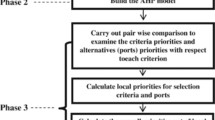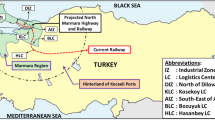Abstract
This study presents the findings of a survey to determine the service characteristics that shippers consider important when selecting a port and the way these characteristics are prioritised according to their importance. Seven criteria for the port selection decision and four ports were identified, and the decision problem was structured into a three-level hierarchy using the Analytic Hierarchy Process. The findings suggest that shippers place high emphasis on efficiency, frequency of ship visits and adequate infrastructure, while quick response to port users' needs was insignificant to them. Results from the study are of interest to Port managers because they provide essential information on the key factors that come into the decision process of port users, thus, identifying the strengths and weaknesses of the ports.

Similar content being viewed by others
References
Bardi, EJ . 1973: Carrier selection from one mode. Transportation Journal 13: 23–29.
Bayliss, EJ and Edwards, SL . 1970: Industrial Demand for Transport. Ministry of Transport: London.
Beynon, M . 2002: An analysis of distributions of priority values from alternative comparision scales within AHP. European Journal of Operational Research 140: 104–117.
Bird, J . 1988: Freight forwarders speak: the perception of route competition via seaports in the European communities research project. Maritime Policy and Management 15: 1.
Branch, AE . 1986: Elements of Port Operation and Management. Chapman and Hall Ltd: London.
Brooks, MR . 1984: An alternative theoretical approach to the evaluation of liner shipping (Part 1: Situational factors). Maritime Policy and Management 11: 35–43.
Brooks, MR . 1985: An alternative theoretical approach to the evaluation of liner shipping (Part 2, Choice Criteria). Maritime Policy and Management 12: 145–155.
Chang, YH and Yeh, CH . 2001: Evaluating airline competitiveness using multi-attribute decision-making. Omega 29: 405–415.
Chou, TY and Liang, GS . 2001: Application of a fuzzy multi-criteria decision-making model for shipping company performance evaluation. Maritime Policy and Management 28: 375–392.
Chwolka, A and Raith, M . 2001: Group preference aggregation with the AHP: implications for multiple issue agendas. European Journal of Operational Research 132: 176–186.
Cook, WR . 1967: Transportation decisions of certain firms in the black country. Journal of Transport Economics and Policy 1: 325–344.
D'Este, GM and Meyrick, S . 1992: Carrier selection in a RO/RO ferry trade (Part 1: decision factors and attitudes). Maritime Policy and Management 19: 115–126.
Dey, PK . 2004: Benchmarking project management practices of Caribbean organizations using Analytic Hierarchy Process. Benchmarking: An International Journal 9: 326–356.
Expert Choice Software. 1994 Expert Choice Inc.: Pittsburgh, PA.
Frankel, EG . 1992: Hierarchical logic in shipping policy and decision-making. Maritime Policy and Management 19: 211–221.
Gilmour, P . 1976: Some policy implications of subjective factors in the modal choice for freight movements. The Logistics and Transportation Review 12: 39–57.
Lai, SK and Hopkins, LD . 1995: Can decision-makers express multi-attribute preferences using AHP and MUT? An experiment. Environment and planning B: Planning and Design 22: 21–34.
Lirn, TC, Thanopoulou, HA and Beresford, AKC . 2003: Transshipment port selection and decision-making behaviour: analysing the Taiwanese case. International Journal of Logistics – Research and Applications 6: 229–244.
Lirn, TC, Thanopoutou, HA, Beynon, MJ and Beresford, AKC . 2004: An application of AHP on transshipment port selection: a global perspective. Maritime Economics and Logistics 6: 70–91.
Malchow, M and Kanafani, A . 2001: A Mathematical Analysis of the Significance of Port Charges. The International Association of Maritime Economists Annual Conference 2001 Conference Proceedings, Hong Kong, pp. 923–936.
McGinnis, MA . 1979: Shipper attitudes towards freight transport choice: a factor analytic study. International Journal of Physical Distribution and Materials Management 10: 25–34.
Meyrick, S and D'Este, G . 1989: More than the bottom line – how users select a shipping service. Proceedings of the 14th Australian Transportation Research Forum, Perth, Australia, September 1989, pp. 65–81.
Murphy, P, Daley, J and Dalenberg, D . 1991: Selecting links and nodes in international transportation: an intermediary's perspective. Transportation Journal 31: 33–40.
Murphy, P, Daley, J and Dalenberg, D . 1992: Port selection criteria: an application of a transport research framework. Logistics and Transportation Review 28: 237–255.
Ogden, KW and Rattray, AL . 1982: Analysis of freight mode choice. Proceedings of the 7th Australian Transport Research Forum Hobart, Australia, pp. 249–276.
Poh, KL and Ang, BW . 1999: Transportation of fuels and policy for Singapore: an AHP planning approach. Computers & Industrial Engineering 37: 507–525.
Rangone, A . 1996: An analytical hierarchy process framework for comparing the overall performance of manufacturing departments. International Journal of Operations & Production Management 16: 104–119.
Saaty, TL . 1980: The Analytic Hierarchy Process,. McGraw-Hill Publications: New York, NY.
Saaty, TL . 1988: Decision Making for Leaders,. RWS Publications: Pittsburgh, PA.
Saaty, TL and Vargas, LG . 1994: Decision Making in Economic, Political, Social and Technological Environments with the Analytic Hierarchy Process. RWS Publications: Pittsburgh, PA.
Saleh, F and Lalonde, BJ . 1972: Industrial buying behaviour and the motor carrier Selection decision. Journal of Purchasing 8: 18–33.
Selly, MA and Forman, EH . 2002: Decision by objectives 1st edn, World Scientific Pub Co: Petersburg.
Slack, B . 1985: Containerisation and inter-port competition. Maritime Policy and Management 12: 293–304.
Song, DW and Yeo, KT . 2004: A competitive analysis of Chinese container ports using the Analytic Hierarchy Process. Maritime Economics and Logistics 6: 34–52.
Ta, HP and Har, KY . 2000: A study of bank selection decision in Singapore using the Analytic Hierarchy Process. International Journal of Bank Marketing 18: 170–180.
Tongzon, J . 1995: Determinants of port performance and efficiency. Transportation Research 29A: 245–252.
Tongzon, J . 2002: Port choice determinants in a competitive environment. The International Association of Maritime Economists Annual Conference 2002 Conference Proceedings Panama.
Tzeng, GH and Wang, RT . 1994: Application of AHP and Fuzzy MADM to the evaluation of a bus system's performance in Taipei City. Third International Symposium on the Analytical Hierarchy Process George Washington University, Washington, DC, 11–13 July 1994.
Vreeker, R, Nijkamp, P and Welle, CT . 2002: A multicriteria decision support methodology for evaluating airport expansion plans. Transportation Research: Part D 7: 27–47.
Willingale, MC . 1984: Ship-operator port-routeing behaviour and the development process. In: Hoyle, B.S. and Hilling, D. (eds) Seaport Systems and Spatial Change. John Wiley & Sons: New York. pp. 43–59.
Wilson, FR, Bisson, BJ and Kobia, BK . 1986: Factors that determine mode choice in the transportation of general freight. Transportation Research Record 1061: 26–31.
Zahedi, F . 1986: The Analytic Process: survey of the method and its applications. Interfaces 16: 96–108.
Author information
Authors and Affiliations
Appendices
Appendix I
INPUT MATRIX
When employing the AHP methodology, the input data for the decision problem consists of matrices of pairwise comparisons of elements of one level that contribute to achieving the objectives of the immediate preceding level. Thus, the Level 2 attributes are compared pairwise with one another, in relation to their importance to the Level 1 objective. If there are n attributes in Level 2 of the hierarchy, a total of n(n−1)/2 comparisons are required. This results in a n × n matrix. Similarly, the Level 3 attributes are pairwise compared with one another, in relation to their preference with regard to each of the n m × m matrices.
For this study, the input matrix of the respondents' judgments would look like the following:

The matrix shows that attribute 1 is α times more important than attribute 2 and is k times more important than attribute 7. the matrix has the property that its principal diagonal elements are all unity because when compared with itself, each elements has equal importance. The lower triangle elements of the matrix are the reciprocal of upper triangle elements. Thus, pairwise comparisons are collected for only half of the matrix elements.
Appendix II
THE EIGENVALUE METHOD
The eigenvalue method of the AHP takes in as inputs the pairwise comparisons of the respondents and judgements and produces the relative weights of the elements at each level of the decision hierarchy. Following Zahedi (1986), if the evaluator could know the actual relative weights of n elements (at one level of the hierarchy with respect to the level above), the matrix of the pairwise comparisons would be

In this case, the relative weights could be obtained from each of the n rows of matrix A. In other words, matrix A has rank 1 and the following holds:

Where W is the vector of actual relative weights and n is the number of elements. In matrix algebra, n and W are called the eigenvalue and the right eigenvector of A respectively.
The AHP posits that the evaluator does not know W and therefore, is not able to produce the pairwise relative weights of matrix A accurately. Thus, the observed matrix A contains inconsistencies. The estimation of W, denoted by Ŵ could be obtained from

where  is the observed matrix of pairwise comparisons, λ max is the largest eigenvalue of Â, and is its right eigenvector.
Saaty (1980) has shown that λ max can be considered an estimation of n and that λ max is always greater than or equal to n. Furthermore, when the observed values of  are consistent, the value of computed λ max is very close to n. this property allows the construction of the consistency index (C.I) as

and the construction of the consistency ratio (C.R) as

where ACI is the average index of randomly generated weights. The computational algorithm is available in Expert Choice Software.
In summary, the eigenvalue method in the AHP is one of the widely used methods for estimating the relative weights of W from the matrix of pairwise comparisons.
Rights and permissions
About this article
Cite this article
Ugboma, C., Ugboma, O. & Ogwude, I. An Analytic Hierarchy Process (AHP) Approach to Port Selection Decisions – Empirical Evidence from Nigerian Ports. Marit Econ Logist 8, 251–266 (2006). https://doi.org/10.1057/palgrave.mel.9100160
Published:
Issue Date:
DOI: https://doi.org/10.1057/palgrave.mel.9100160




